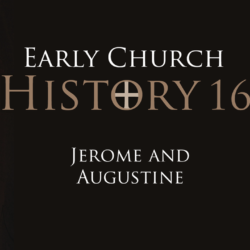Did you know that controversies surrounding how to translate gender in the Bible had a major impact on Bible translation over the last 30 years? In this episode we’ll briefly overview various feminist movements before examining the NRSV, which proved to be a forerunner for gender inclusive Bible translations. Next we’ll take a journey through the NIVI and TNIV controversies at the turn of the 21st century before seeing how evangelical Bible translations both reacted against (ESV, HCSB) and appropriated (NIV2011, CSB) varying degrees of gender accuracy into their Bibles.
—— Books ——
- The Handbook of Nonsexist Writing: For Writers, Editors, and Speakers by Casey Miller and Kate Swift, 1980
- “Femme Fatale” by Susan Olasky, World, March 29, 1997
- Colorado Springs Guidelines “Statement by Participants in the Conference on Gender-Related Language in Scripture” May 27, 1997
- “Bailing Out the Stealth Bible” by Susan Olasky, World Magazine, June 14, 1997
- “Hands Off My NIV!” by Doug LeBlanc, Christianity Today, June 16, 1997
- What’s Wrong with Gender-Neutral Bible Translations? by Wayne Gruden, 1997
- D. A. Carson, The Inclusive Language Debate: A Plea for Realism
- Mark L. Strauss, Distorting Scripture? The Challenge of Bible Translation and Gender Accuracy
- The Gender-Neutral Bible Controversy: Muting the Masculinity of God’s Words by Wayne Gruden and Vern Polythress, 2000
- Two Views on Women in Ministry by Linda L. Belleville, Craig L. Blomberg, Craig S. Keener, Thomas R. Schreiner, 2001, updated 2005
- Southern Baptist Convention Resolution “On Today’s New International Version,” June 11-12, 2002
- How To Choose a Translation for All It’s Worth by Gordon Fee and Mark Strauss, 2007 (see especially chapter chapter 7)
- “Why the English Standard Version (ESV) Should Not Become the Standard English Version” by Mark Strauss, 2008 (presented at ETS)
- “An Evaluation of Gender Language in the 2011 Edition of the NIV Bible,” Council on Biblical Manhood and Womanhood, June 6, 2011
- Jesus, Justice, and Gender Roles by Kathy Keller, 2012
—— Links ——
- Check out all the lectures in How We Got the Bible
- See what other classes are available here or on the Restitutio Classes podcast (subscribe in Apple, Spotify, RSS feed)
- If you’d like to support Restitutio, you can donate here.
- Intro music: Good Vibes by MBB Attribution-ShareAlike 3.0 Unported (CC BY-SA 3.0) Free Download / Stream: Music promoted by Audio Library







Great presentation on the relative influences of gender in translations. I would just point out that while I do read from the HCSB, the CSB actually goes well beyond just providing inclusiveness in their pronouns. A main point of contention I have with the newer CSB is their translation of John 1:18. As I’m sure you’re aware, we have “begotten god” from the Alexandrian majority and “begotten son” from the Byzantine. The CSB goes well beyond either translation and instead creates “who is himself god” in their rendering. It would appear as though Trinitarian influences may also have had a part in the CSB as well.
Thanks Sean,, for your recent podcast in which you presented on ‘gender ‘ translation issues and approaches.
I have to say, i thought you tackled the ‘minefield’ with dexterity and discretion and, i hope, came out of the podcast relatively unscathed!!
Interestingly, i was interested that the discussion and translational issues were all focused on heterosexual gender selection issues and did not attempt to tackle LGBT translational issues!!!!
Of course, that’s the point. Assuming one were to adopt a very inclusive / neutral heterosexual gender approach – perhaps that might be acceptable to LGBT groups (or may be not?!)
I guess i came away from your very helpful exposure to the issues and solutions offered, thinking:
A. In the scheme of things, these ‘gender’ translational issues are a ‘flash in the pan’ compared with the timeframes we are otherwise addressing;
B. adopting the Restitutio motto – of searching for and promoting “authentic Christianity”, for my part at least, I would hope to be focussed on truly, and to the best of my ability, translating the accurate words that were written (referring to whatever gender was written, and then provide notes about the likely ‘authentic meaning or understanding would have been for that text as at the time they were written.
But then I guess I’m a keep it honest and simple sort of guy.
I can understand translating approaches based on some cultural norms so as not to create confusion, & to promote good understanding of God’s message!
But this current gender environment causes ongoing issues that will have frankly disappeared in 20 years time.
Let’s be focused on achieving an authentic balance between readability and accuracy.
If we feel it necessary, let’s be about good footnotes to explain things of a then cultural or communications nature, that are different from our current post- WW2 to post Millennial view point especially of “ political correctness. )
Anyway, once again – thank you for this wonderful series of enlightening and strengthin!!!
Dear Durham;
Quick points:
Even many pro-homosexual scholars admit that the Bible (in it’s original contexts) condemns same-gender sexual practices, unconditionally and universally. It would be a mistake to interpret the Bible through any lens of Postmodernism and/or cultural Marxism..
I don’t think the author of Jesus Justice and Gender Roles makes good or convincing arguments at all. First, she never talks about the textual problems with 1 Corinthians 14:34-35. Those verses appear in different places in different texts and not at all in others. Gordon Fee as well as many other scholars say it’s not authentic.. It says that the law says women should be silent and the law says no such thing.
Moving on to 1 Timothy, most scholars say that 1 Timothy was not written by Paul. It claims to be written by Paul but is not. Every person I’ve talked to who has theological training has been aware of this. It seems to be common knowledge and when I learned this not too long ago I felt put out that people seem to be wimping out and not talking about it because it would stir the pot.
Setting that aside and coming at it as if it was authentic it seems that what whoever wrote it is talking about is husbands and wives not women and men in general. The text says a woman should not usurp authority over a man singular not men plural. And the words for man and woman and husbands and wives are the same. Then it talks about the order of creation and childbearing which seems to me to pertain to husbands and wives and not men and women in general.
Women spoke and taught and prophesied authoritatively in leadership in the early church. Junia was an apostle. A good book on the subject is by Eldon Jay Epp. Paul tells Christians to obey women co workers that were sent to them. A prophesy, if it is a true prophesy from the Lord is an authoritative utterance.
I believe what scripture teaches is that wives are to obey their husbands but in the church there is no male, female, Jew or Greek. There is no prohibition in scripture against women in any role in the church.
I like the articles on the subject of women elders in the early church by the scholar linked below.
https://margmowczko.com/women-elders-new-testament/
Hi, Sean. Thanks for clarifying some things about the Bible and gender. It was a verry good overview of gender and Bible translation history.
I agree that it is unnecessary to “de-genderize” God, even though He clearly has both masculine and feminine attributes. I also think it’s okay to use more inclusive language when talking about men and women in the church. If the subjects of the passage include both men and women, why be exclusive, unless you have an anti-female bias? Gender inclusiveness does not necessarily have to be equated with gender neutrality. Given our modern culture and its use of language, I think the publishers of the CSB made a good move to be more inclusive of the gender that makes up more than half of the body of Christ.
As far as your sources on gender roles in the church, I was surprised to find out that you highly recommend the book Jesus, Justice, and Gender Roles by Kathy Keller. I read it and found it wholly unconvincing and very biased. I would push back on your claim to be open to both complementarian and egalitarian views if you endorse the views in the book. I personally find Keller to be very limiting of women in the church without much biblical evidence to back up her views.
May I suggest a more thorough scholarly work on women in the Church? I have done quite a bit of research on this topic and I found Paul and Gender by Cynthia Westfall to be a very well-researched and reliable source on the subject. I believe she takes the position of complementarianism in marriage and egalitarianism in the church, which is mostly where I fall on the subject as well. Her views are very well-balanced, she does not approach this subject from a radical feminist position as quite a few other egalitarian scholars do.
The Bible shows many examples of Jesus and Paul including women in ministry in ways that would have been very radical for their time. I think we as Biblical Unitarians should be as inclusive as they were. As a female who enjoys sharing the full fellowship and work of Christ in the Church, I appreciate churches and individuals who are inclusive of both men and women.